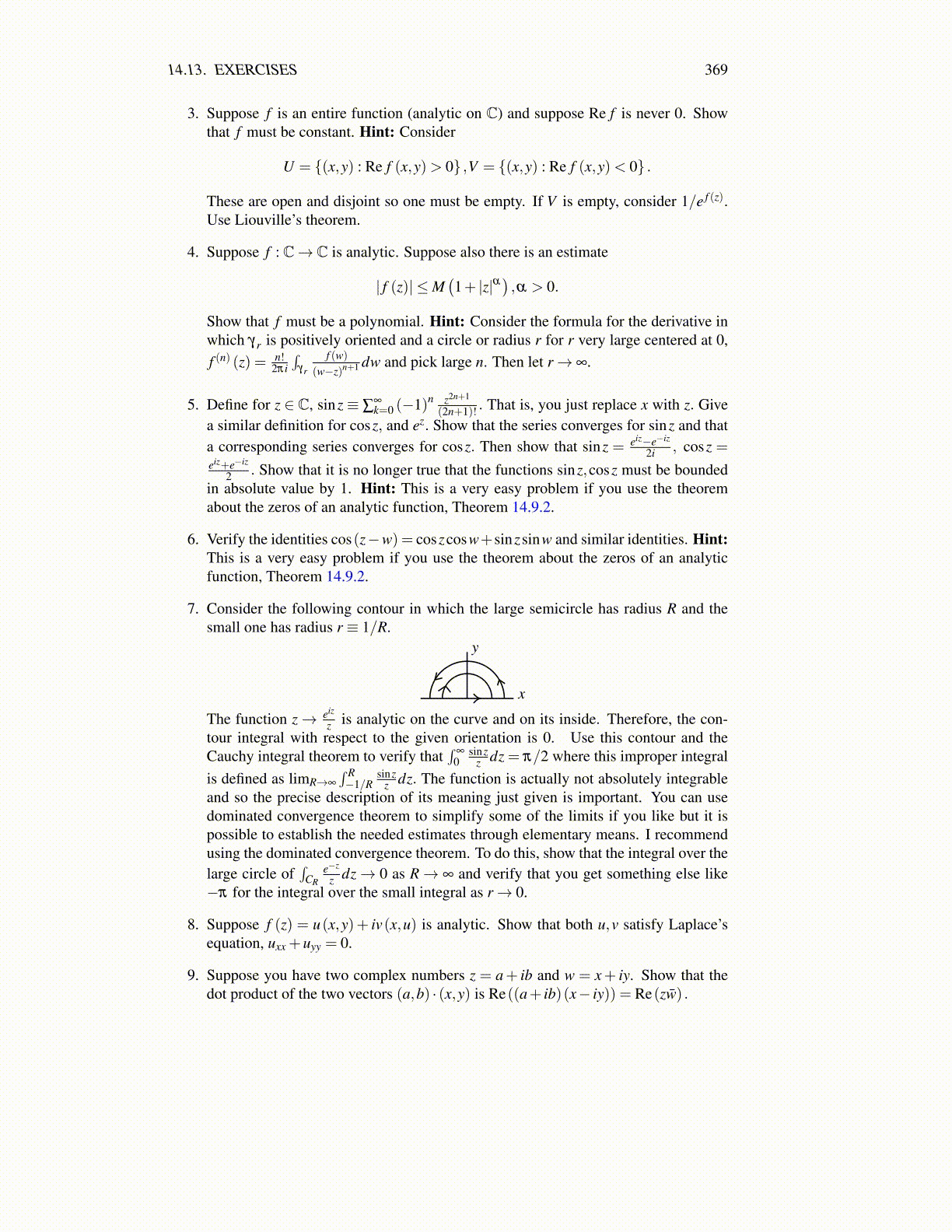
14.13. EXERCISES 369
3. Suppose f is an entire function (analytic on C) and suppose Re f is never 0. Showthat f must be constant. Hint: Consider
U = {(x,y) : Re f (x,y)> 0} ,V = {(x,y) : Re f (x,y)< 0} .
These are open and disjoint so one must be empty. If V is empty, consider 1/e f (z).Use Liouville’s theorem.
4. Suppose f : C→ C is analytic. Suppose also there is an estimate
| f (z)| ≤M(1+ |z|α
),α > 0.
Show that f must be a polynomial. Hint: Consider the formula for the derivative inwhich γr is positively oriented and a circle or radius r for r very large centered at 0,f (n) (z) = n!
2πi∫
γr
f (w)(w−z)n+1 dw and pick large n. Then let r→ ∞.
5. Define for z ∈ C, sinz ≡ ∑∞k=0 (−1)n z2n+1
(2n+1)! . That is, you just replace x with z. Givea similar definition for cosz, and ez. Show that the series converges for sinz and thata corresponding series converges for cosz. Then show that sinz = eiz−e−iz
2i , cosz =eiz+e−iz
2 . Show that it is no longer true that the functions sinz,cosz must be boundedin absolute value by 1. Hint: This is a very easy problem if you use the theoremabout the zeros of an analytic function, Theorem 14.9.2.
6. Verify the identities cos(z−w) = coszcosw+sinzsinw and similar identities. Hint:This is a very easy problem if you use the theorem about the zeros of an analyticfunction, Theorem 14.9.2.
7. Consider the following contour in which the large semicircle has radius R and thesmall one has radius r ≡ 1/R.
x
y
The function z→ eiz
z is analytic on the curve and on its inside. Therefore, the con-tour integral with respect to the given orientation is 0. Use this contour and theCauchy integral theorem to verify that
∫∞
0sinz
z dz = π/2 where this improper integralis defined as limR→∞
∫ R−1/R
sinzz dz. The function is actually not absolutely integrable
and so the precise description of its meaning just given is important. You can usedominated convergence theorem to simplify some of the limits if you like but it ispossible to establish the needed estimates through elementary means. I recommendusing the dominated convergence theorem. To do this, show that the integral over thelarge circle of
∫CR
e−z
z dz→ 0 as R→ ∞ and verify that you get something else like−π for the integral over the small integral as r→ 0.
8. Suppose f (z) = u(x,y)+ iv(x,u) is analytic. Show that both u,v satisfy Laplace’sequation, uxx +uyy = 0.
9. Suppose you have two complex numbers z = a+ ib and w = x+ iy. Show that thedot product of the two vectors (a,b) · (x,y) is Re((a+ ib)(x− iy)) = Re(zw̄) .